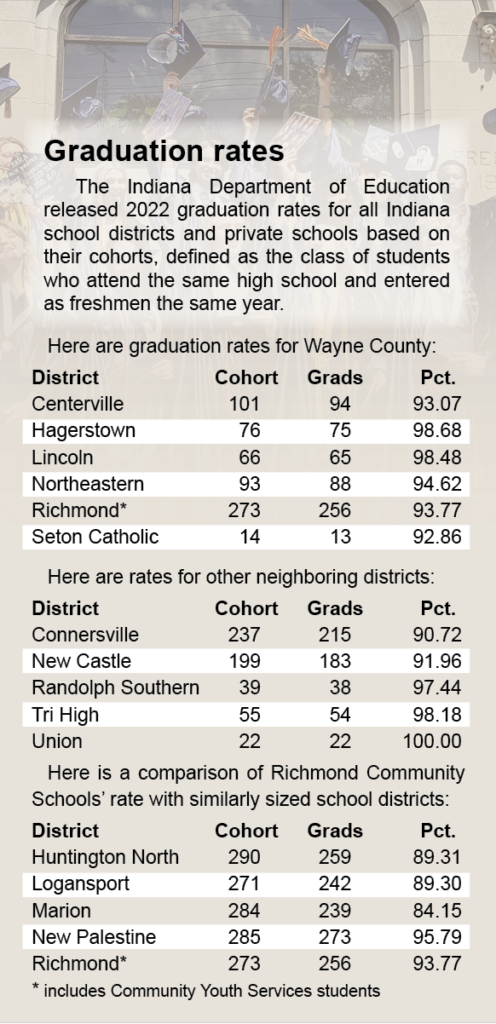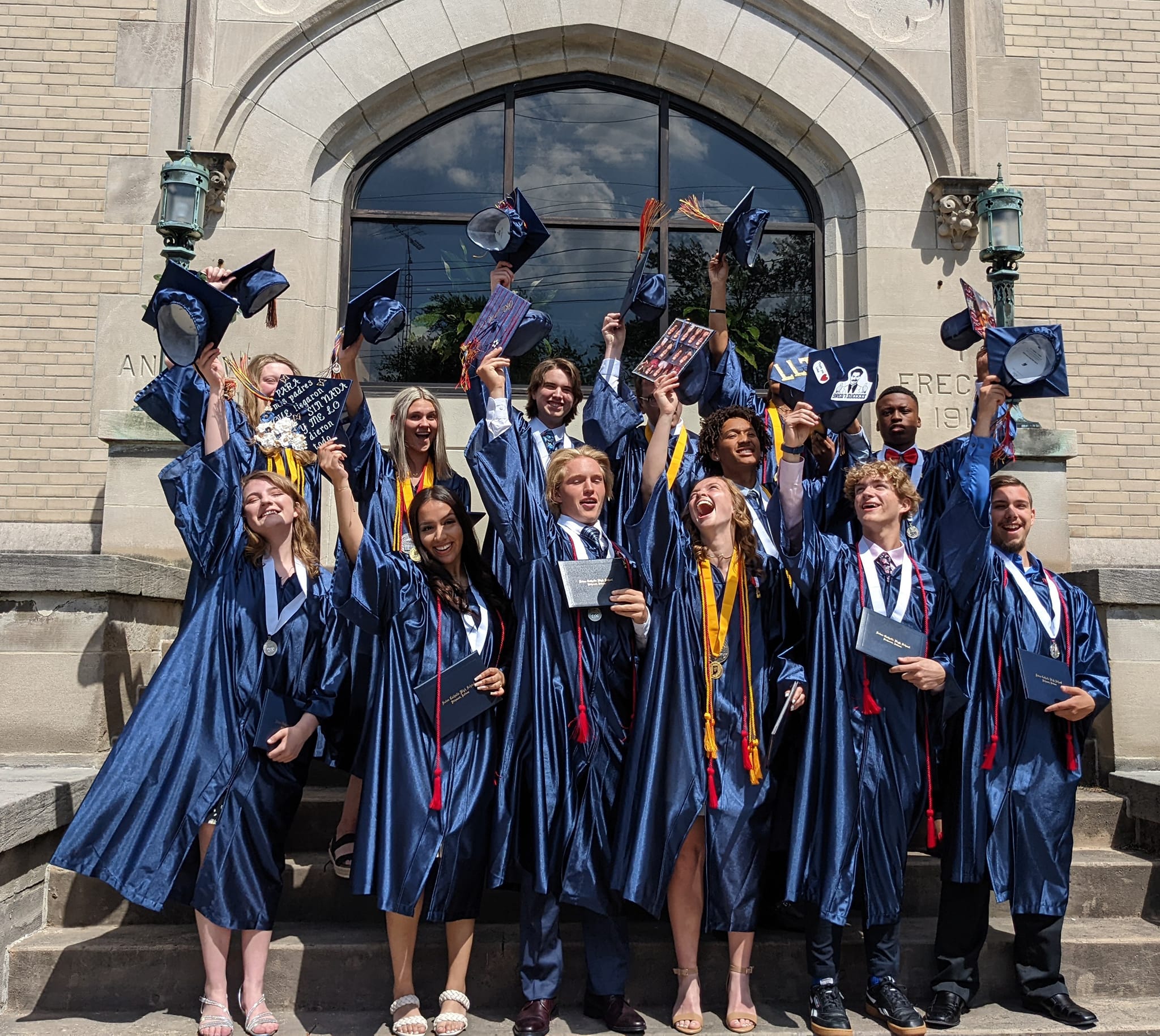About 95% of regular students who start here in 9th grade earn diploma
By Bob Hansen and Millicent Martin Emery
Nearly all students who start high school in Wayne County graduate with a diploma, excepting those who go into special programs.
That’s the news in a nutshell from a statewide listing of high school graduation rates. But it is a bit more complicated than just comparing the number of ninth graders with the number of students from that class who get a diploma.
Indiana Department of Education lists graduation rates annually, releasing its 2022 list on Dec. 30. Every Wayne County school graduated more than 92%, ranking all in the top third of the state.
“A good (graduation) rate is important,” Western Wayne Schools Superintendent Andy Stover said in talking about Lincoln Middle/High School’s 98.48% graduation rate. “Our job is to make sure the kids have a better chance of being successful by making sure each of them receives a diploma.”
 Graduation rate is figured as a percentage of what is called a cohort. The cohort represents students who entered the school as ninth graders. The graduation rate considers students who transferred out from the cohort and those who dropped out.
Graduation rate is figured as a percentage of what is called a cohort. The cohort represents students who entered the school as ninth graders. The graduation rate considers students who transferred out from the cohort and those who dropped out.
Raw figures show that only 32 students who were in the Wayne County Class of 2022 did not graduate. That figure does not include some students who were in special programs such as Richmond’s Community Youth Services or those who attended school at the Excel Center, which provides alternative schooling that can lead to a high school diploma.
At schools with smaller enrollment, each student lost represents a larger percentage of would-be graduates. Hagerstown and Lincoln each graduated all but one in their cohort, but Lincoln, with 10 fewer students, scored a slightly lower graduation rate.
Richmond scored 93.77% with 17 students who did not graduate while Centerville, where the graduates numbered seven fewer than the cohort, scored 93.07%.
At Northeastern Wayne School Corporation, Superintendent Matthew Hicks and high school principal John Markward responded to the graduation rate report. They wrote, “[W]hen you have graduating classes of approximately 100 like we do, each percentage point of change is a student when it comes to graduation rate. We take that very seriously as a district because each of our Knights is important to us.”
Centerville Senior High School Principal Tim Hollendonner said he believes schools will continue to see an impact for several years due to COVID-19.
“We are seeing a significant learning gap each year due to the shortened 2020 school year and students choosing to do virtual learning for the 2020-21 school year,” Hollendonner said.
RHS Principal Rae Woolpy said that the district’s graduation rate “absolutely” was affected by COVID for several reasons, such as its impact on students’ mental health.
Woolpy said constant quarantining of students also was a factor, because some had to miss weeks of school after being close contacts.
Hicks said, “We had a number of students who never made a full return to us after we closed in the spring of 2020 (for the COVID pandemic) and we have seen a decline in the graduation rate as a result. We anticipate the dip to continue into this year’s graduation rate as well as we have some students who are still trying to make up credits lost during that time frame.”
School administrators said attendance is an indicator of school success.
“Attendance is a big contributor to a student earning a diploma,” said Emily Schaeffer, Nettle Creek School Corporation superintendent. “We also see more success in students who attend Hagerstown Jr.-Sr. High School by their seventh or eighth grade school year rather than enrolling in their junior or senior year.”
At Northeastern, Hicks said, “If you look through those students, attendance is a common trend that is revealed. They tend to miss more days than their peers and that can be a compounding issue depending on the timing of the absences.”
He added, “I would like to point out that every student who is physically in our building does graduate … If they will come, we have shown we can remove a multitude of barriers to help them accomplish the academic work.”
Principals credit local social service agencies such as Communities in Schools of Wayne County and Centerstone for helping students overcome learning obstacles. Those organizations provide everything from mental health services to basic needs such as clothing, food and personal hygiene products.
Woolpy said poor attendance is the main reason that many RHS students struggle to graduate.
“If they are not here, we cannot reach or teach them,” Woolpy said. “Our RHS leadership and district leadership have continued to have discussions on how the juvenile justice system can help with attendance.”
To meet various student interests and needs, Richmond offers three alternative programs — Credit Recovery, through which students can complete credits; Alternative Program half or full day at RHS; and Richmond Graduation Academy, which is a total online program option for RHS students who qualify.
Educators try to look ahead with their students to ensure they are on track to graduate.
“Nettle Creek is being very proactive in identifying students who are not on track to graduate as soon as the end of their ninth-grade school year,” Schaeffer said. “Once students are identified, we can put intervention and support in place to help them achieve a diploma.”
Hollendonner said Centerville has offered credit recovery courses for students in need of obtaining lost credits or have taken courses unsuccessfully.
He said CSHS’s guidance department works tirelessly in developing a map for students to follow when choosing courses that they must satisfy and when in pursuit of their recommended pathway.
CSHS has an Early Warning Intervention and Monitoring program where educators identify students every nine weeks based on the amount of flags such as attendance issues, concerns about grades and/or behaviors, and credit deficiency.
“Having choices such as a high school equivalency option or going to the EXCEL center has impacted our numbers,” Hollendonner said. “Centerville requires 48 credits, whereas other schools in the county require 40 or 42 credits have affected those numbers as well. The community continues to support the importance of a high school diploma. Having one opens so many more avenues for a young adult to be successful in pursuing their career/endeavors later in life.”

